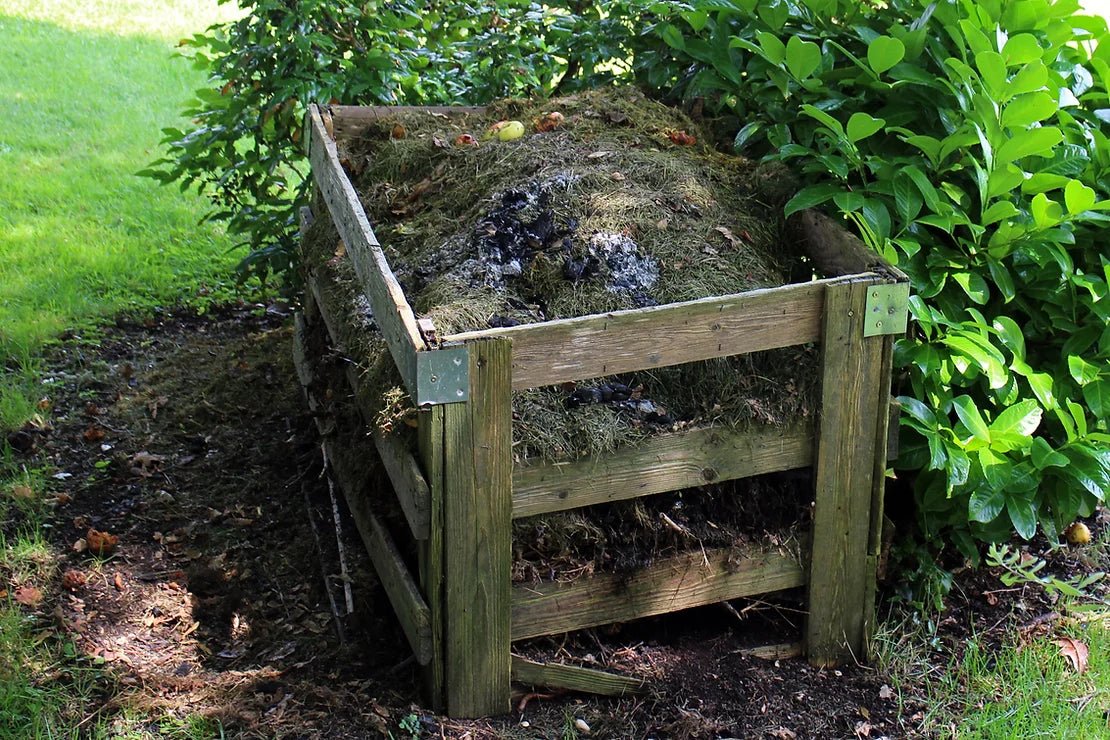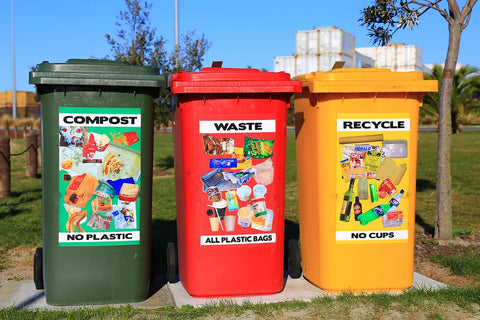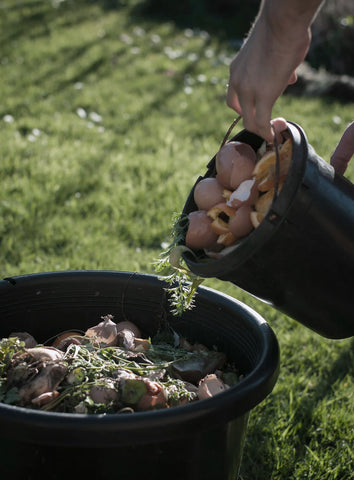A Complete Guide to Composting

Food for thought: 40 percent of the food produced in the United States goes to waste. That’s right, 40%! On average, each person throws away 400 pounds of food every year. This is shocking for a country where 40 million people struggle to put food on the table meanwhile, precious resources such as land, fresh water, energy and labor are wasted on food production.
So, where does all this food waste go?
90% of the food waste goes to landfill. Problem solved, right? Nope, not even close! Once the food waste reaches the landfill, it ends up buried under layers and layers of waste (including non-compostable plastics). With barely any access to light or oxygen, said waste decomposes improperly and releases methane - a big contributor to global warming that is 28 times more powerful than carbon dioxide. The carbon footprint from food waste is so monumental that it surpasses the effects of the airline industry.

Luckily, there are actions we can all take to make big scale changes!
First, we have to try nipping the problem right at the bud by reducing the amount of waste we generate. Here are a few simple tips that can make all the difference:
-
Avoid overcrowding your refrigerator for better circulation
-
Clean fridge regularly to prevent bacterial growth
-
Organize fridge content to keep produce visible
-
Store opened packaged foods in airtight containers, silicone storage bags or food huggers
-
Utilize the items closest to expiration
-
Freeze leftovers
-
Donate unopened food that hasn’t passed its expiration date
It is inevitable for some waste to accumulate and that’s where composting swoops in to save the day!

What is composting?
Composting is a form of waste disposal that involves breaking down organic matter into a nutrient-rich substance called compost - or black gold, as green-thumbers refer to it. Microorganisms (bacteria, fungi, earthworms etc.) help engine the process by taking up carbon, nitrogen (from the food scraps), air and water to work their magic. During peak decomposition, the temperatures rise to 130°F or higher, then drop to normal temperatures. At this point, the black gold is ready to be used.
Composting is not only beneficial for the environment, it’s also an excellent soil amendment. A generous sprinkle on your flowerbed, lawn, and veggie garden allows you to grow some kickass, fragrant and delicious plants like you’ve never had before! Plus, you’ll save money on fertilizer and we’re all about sustainability of all forms hehe.

Myths about composting
Despite being one of the most eco-friendly ways of dealing with waste, many are still iffy about composting due to a slew of misconceptions. People assume it’s cumbersome, difficult, expensive, smelly, messy, etc. However, after the initial learning curve (which every habit inevitably goes through), composting can be easy, fun, rewarding and even therapeutic!
Read ahead for a simple guide to help you through your composting journey regardless of your living situation. Let’s start with the basics, shall we?
There are two major types of composting: backyard composting and commercial composting.

Backyard composting
What you’ll need:
-
An eco-friendly trash bag to collect your food scraps during the day
-
A plastic, wooden, or metal compost bin
-
A scoop shovel to reach the bottom of the pile
-
A pitchfork to turn the pile
-
A suitable location to place the bin in your backyard
What can you compost?
Greens (nitrogen-boosting items):
-
Fruits and vegetable scraps
-
Coffee grounds
-
Strained tea
-
Grass clippings
-
Leaves
Browns (carbon-based items):
-
Dead plants
-
Cardboard
-
Saw dust
-
Rinsed eggshells
-
Newspapers

What you can’t compost!
-
Meat
-
Fish
-
Fat (butter or oil)
-
Bones
-
Dairy
-
Diseased yard waste
-
Pet waste
Note, composting these no-no items can be a cause for a disease outbreak and entice undesired visitors (even if cute and fluffy).
It’s worth mentioning that the size of the material matters - smaller pieces decompose much quicker. For a better outcome, we recommend chopping, crushing and shredding your food scraps in advance.
What about ratios?
The proportion of browns to greens is crucial and can influence results. There’s no agreed-upon ratio but 2:1 is said to be the adequate mix. It doesn’t require exact measurements; you just need to keep an eye on your pile and adjust the ratio as you see fit. Add some browns every time you put in some greens. If your compost pile starts turning slimy and smelly, throw in some dry browns. If it’s too dry, sprinkle some water.
No visible changes? Add more greens. That’s it! Easy-peasy!

How to layer compost:
To ensure maximum airflow, crisscross some sticks at the bottom of the bin and then add a thin layer of brown materials on top of the sticks. Afterwards, place the rest of the composting loosely for proper aeration.
Try not to add a huge volume of one type of material in one shot. For instance, if you have a large batch of eggshells, put it in a separate cardboard box for later use.
Stir up the compost pile with a shovel every week to keep the overall temperature leveled.
If you want to supercharge the decomposition process, add some earthworms! You can find and purchase them from local composting farms and/or search the web and place an order.
How long does it take to compost?
Depending on various factors like volume, size of waste materials, moisture and oxygen levels - and of course your own nurturing skills - it takes anywhere from 1 to 12 months for compost to fully breakdown.
How do you know compost is ready?
There are a few tell-tale signs that let you know when compost is ready for use:
-
Appearance – dark and crumbly and almost all the food scraps will have disappeared
-
Smell - a pleasantly rich earthy smell unlike rotting vegetables
-
Size - the original pile will have shrunk by half its size

Commercial composting
Commercial composting is designed to process municipal and commercial waste on a large scale. This works for big cities where people don’t have the time or space for home composting projects. Commercial and backyard composting differs in many respects, but both results are essentially important and beneficial for the earth.
Commercial composting facilities have special equipment that break down both plant and animal-based food waste including dairy and meat. The compost goes through a screening process where non-organics are removed and the temperature, moisture, and airflow are closely monitored. The compost is then sold off to large growers and landscape services.
How can I access commercial composting?
You can find the nearest composting facility in your local area by making a call to city hall or doing a quick internet search. Online resources such as Litterless can also come in handy. Some facilities offer compost pickup for residents while others maintain drop-off sites - choose a program that best compliments your lifestyle.
 Other composting options:
Other composting options:
Worm composting or Vermicomposting
This type of composting uses worms (usually red wrigglers) to break down food scraps. You can do this anywhere - indoors or out. All you’ll need is a breathable bin, some dirt, worms, and a nice blend of green and brown materials to get you started! Keep in mind, vermicomposting is a small-scale operation and there’s only so much that earthworms can snarf up in a day.
Bokashi Composting
Bokashi is a composting method invented in Japan that relies on fermentation to break down food scraps including dairy and meat. A layer of bran is sprinkled atop compost material in an airtight bin for 10-14 days. The only downside to the bokashi method is that it makes the compost too acidic to use on plants which means it has to be buried deeper in the ground.
Community gardening
Some cities provide individual or group gardening spaces for community members accompanied by compost system features. If you’re interested in this option, look through your city or neighborhood’s website to check for availability.
 What if I live in an apartment building, can I still compost?
What if I live in an apartment building, can I still compost?
Of course, you can! If you live in an apartment or condo without a backyard or balcony, there are four ways you can optimize your food waste:
-
Compost it - vermicomposting or bokashi composting works perfectly indoors.
-
Bag it – use compostable bags to carry your food scraps to your compost cart.
-
Bin it - store your food scraps in a reusable, airtight bin lined with a compostable bag until it needs to be dropped off or picked up.
-
Freeze it – put your scraps in a plastic bag and stash them in the freezer. There’ll be no foul smells, no mold and fungi or pesky pests Once it’s full, drop it off at the nearest commercial composting facility or community garden.
Refer to the backyard composting guide above to find out which food scraps are compostable and which ones to avoid.
Wrapping up
So, there you have it! All the basics you’ll need to start your composting journey. You don’t need a huge backyard or bank account. Find a method that works for you and take the plunge! Sure, you’ll probably make mistakes at first - as with starting anything new - but you’ll get a hang of it and know you’ll be part of the big picture solution. You’ll also be able to step up your gardening game and take care of the planet at the same time. Happy composting!





Comments